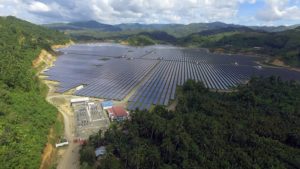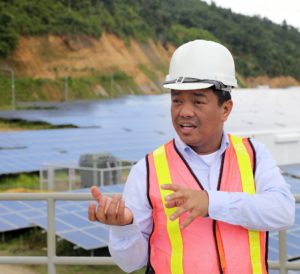
At least a hundred thousand solar panels stretch out across the 73-hectare mountain lot in Barangay Talavera in Toledo City, a facility owned by Citicore
Power Inc. CDN DRONE PHOTO/TONEE DESPOJO
Citicore harnesses power of the sun in 73-hectare lot in midwestern Cebu town
Toledo City does not only feature mining sites. It is also home to the biggest solar power plant in Cebu.
Renewable energy company Citicore Power Inc. (CPI) has invested more than P4 billion for the establishment of its 60-megawatt solar power plant located in Barangay Talavera.
Edwin Josef, CPI’s vice president for operations, said that one of the reasons they chose to invest in the mid-western city of Toledo was the availability of space for their facility — which is the biggest among their three solar plants in the country.
The First Toledo Solar Energy Corp. (FTSEC) is spread out on a 73-hectare property being leased by CPI from an owner who has already cleared the area before the firm started construction in October 2015.
“Cebu is where most of the load in the Visayas comes from. There are a lot of solar power plants but these are in Negros. But the load is here. The investments and industries here are growing,” Josef told Cebu Daily News during a tour of the facility last Wednesday.
The FTSEC started dispatching power to the National Grid Corporation of the Philippines (NGCP) last June 30, 2016.
The solar power plant is located just 800 meters away from NGCP’s Calung-Calung substation.
It has a dependable capacity of 48 MW on normal days. But this could go lower to up to only 17 MW on rainy and cloudy days.
However, the FTSEC provides an hourly forecast of their available power to the NGCP which would then match it to their supply and demand data.
“An ordinary household consumes around 300 kilowatt hours a month. At this rate, the TFSEC powers 18,000 homes (connected to the Visayas grid).
We are powering 18,000 homes with renewable, clean energy,” Josef said.
Why Toledo
CPI is the sister company of Megawide Construction Corp., one of the two private companies currently managing the Mactan Cebu International Airport (MCIA).
Josef said that when officials of Megawide explored Cebu a few years back, they also scouted for possible areas in the province for their renewable energy arm which is CPI.
“Toledo was one of the areas which already had a previous developer so the permitting process had started. We arranged with the owner and so everything was accelerated,” he said.
According to Josef, the location was ideal since it was already cleared and was relatively flat. He said this is important for them to maximize the amount of sunlight that their solar panels could absorb in a day.
It takes approximately one hectare to generate one megawatt of solar power.
At the least, it would only take around six months to put up a solar power plant as long as the materials and the space are already available.
For FTSEC, it took two months longer since they had to mobilize equipment in order to construct roads around and within the facility, erect their offices and buildings, and coordinate with the immediate community.
“As part of our thrust to involve the community, we had to hire workers near the area. We had about 3,000 workers helping us when we built the facility,” Josef said.

Edwin Josef, Citicore Power Inc. vice president for operations, explains how the First Toledo Solar Energy Corp. works to a Cebu Daily News team who visited the facility. CDN PHOTO/TONEE DESPOJO
Maintenance
The FTSEC has four regular employees – engineers who are in-charge of operation and maintenance of the facility.
At the same time, they also have third party contractors that provide additional technicians, electricians and utility personnel. They also have 22 security guards that help maintain the security of the entire facility.
Security though is not much of a problem at the FTSEC, said Josef.
Motorcycles and people from the nearby areas can pass through the roads inside the facility subject to inspection by security personnel.
The facility was opened after some of the roads where the people pass through were damaged due to recent calamities.
No high perimeter walls are put up around the facility, only screen fences to delineate the property.
“Since we are the latest player to move into the area, we really have to take care of the community. Whenever there are calamities, we assist them as well. We also have CSR programs to reach out to the communities,” Josef said.
There are a total of 193,440 solar panels in the entire area and 24 inverters scattered around which transforms the energy from the solar panels and brings it to the plant’s transformers before it is dispatched to the NGCP lines.
The panels are slightly tilted to maximize its sunlight absorption and according to Josef, this is also to make sure that when it rains or when the panels are sprinkled with water, it does not settle on the panels. A drainage system was also developed around the solar farm.
“Solar panels can last for 25 years. One of its enemies is dust. So if it becomes dusty, we have a water system so we can do cleaning. We usually do four cleanings in a year. It also helps when it rains to clean it. But too much rain would not be good since there would be not enough sunlight,” Josef explained.
These are also designed to withstand wind speeds of 200 kilometers per hour.
Another advantage of solar power plants, Josef said, is that it does not need a lot of maintenance since it does not have moving parts like diesel plants or even hydropower plants which have turbines. These moving parts usually wear out and would need replacement every now and then.
Solar power plants also do not release any hazardous waste or cause pollution. It does not even produce any noise except for a low hum from its its transformer area.
Josef, who is an electrical engineer by profession, also said that globally, the cost of doing solar power plants has significantly become cheaper over the years.
The bulk or almost 50 percent of the total cost comes from the panels itself which have been decreasing in prices while expanding its capacities, he added.
Expansion
Aside from the FTSEC, the CPI also has two other solar power plants in the country: the Next Generation Power Technology Corp., which operates an 18 MW plant in Mariveles, Bataan; and the Silay Solar Power Inc. which owns a 25 MW plant in Silay City, Negros Occidental.
The plant in Bataan is located on a 37-hectare property. It was inaugurated in February 2016 and started power dispatch and commercial operations last March 2016.
On the other hand, the plant in Silay City is located on a 43-hectare property. Just like the Bataan plant, it was inaugurated in February 2016 and started dispatch and operations in March 2016.
CPI also has two more projects in the pipeline: a 12 MV biomass project in Himamaylan, Negros Occidental; and a 40 MW hydropower project in Echague, Isabela.
For Cebu, Josef said they are also looking at more renewable energy projects in the province.
“We are always looking; not only for solar power. We are a renewable energy company, we are also looking at other sources like biomass and hydro for Cebu,” he said although he added that there are still no concrete plans as of the moment.
Disclaimer: The comments uploaded on this site do not necessarily represent or reflect the views of management and owner of Cebudailynews. We reserve the right to exclude comments that we deem to be inconsistent with our editorial standards.
